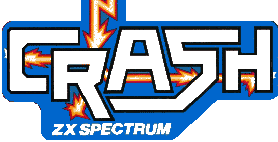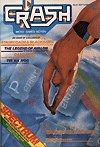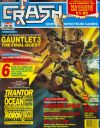|

| Jan 1984 - Jul 1985: |
Roger
Kean |
| Aug 1985 - Mar 1987: |
Graeme
Kidd |
| Apr 1987 - Sep 1987: |
Roger
Kean |
| Oct 1987 - Mar 1988: |
Barnaby
Page |
| Apr 1988 - Jul 1988: |
Steve
Jarratt |
| Aug 1988 - Feb 1989: |
Dominic
Handy |
| Mar 1989 - May 1989: |
Stuart
Wynne |
| Jun 1989 - Mar 1991: |
Oliver
Frey |
| Apr 1991 - Nov 1991: |
Richard
Eddy |
| Dec 1991 - Apr 1992: |
Lucy
Hickson |
|
|
CRASH (1984-92)
was the youngest and shortest-lived of the three main Sinclair
magazines. It occupied a rather different niche from its principal
rivals, Sinclair
User and Your
Spectrum (later Your
Sinclair). Whereas SU aimed itself at
the "serious" Sinclair user and YS at the
techies, CRASH was targeted from the start at the gamers,
as its "loud" title suggested.
This was a smart choice. Although
the other two magazines had a solid niche following, CRASH's
founders recognised from the start that by far the biggest
group of Spectrum users were gamers first and foremost. A
similar approach was adopted for CRASH's sister magazines,
ZZAP!64 (for the Commodore 64) and AMTIX (for
the Amstrad CPC), and proved highly successful on all three
titles. CRASH had the largest circulation of the three
major Sinclair magazines (over 100,000 copies a month at its
peak) and was the standard guide for the software distribution
trade in deciding which games to stock in the shops. The magazine
was, however, the first to succumb to market forces and bit
the dust in the summer of 1992; its rivals lasted another
year before they too died.
A Brief History of CRASH
 For
a highly detailed account of CRASH magazine's development
from 1984 to 1988, see the CRASH
History. For a potted version (which continues
to the magazine's demise in the 1990s), see below. For
a highly detailed account of CRASH magazine's development
from 1984 to 1988, see the CRASH
History. For a potted version (which continues
to the magazine's demise in the 1990s), see below.
-
The origins of CRASH were radically
different from those of its major rivals. It was established
by Newsfield, a publishing company based in Ludlow, Shropshire
to provide a cheap alternative to SU and YS.
The original concept behind CRASH had been to provide
a low-key, low-cost magazine, mostly in monochrome, to
attract the numerous software houses who couldn't afford
the advertising rates of the existing glossies, so several
of the first issues were printed on cheap newsprint with
a heavier colour section wrapped around it. This did not
last long and the magazine soon became as glossy as its
rivals.
- What made CRASH unique was the way that it was
produced. From the start, the magazine aimed to be a fanzine-writ-large:
the games reviewers were native Ludlovians (many in their
teens) and many of the other contributors were genuine Sinclair
enthusiasts rather than simply jobbing journalists working
for a large publishing corporation. The strategy gaming
correspondent, for example, was a (female) Oxford University
student. This gave the magazine a feel of being a professional
publication produced by enthusiastic amateurs; not quite
the case, of course, but enough to give it a very different
flavour from YS or SU.
- CRASH's formula was so successful for so long that
it went through surprisingly few major changes during its
eight years of publication. From its launch issue in April
1984 through to mid-1989, it was a fairly thick publication
of upwards of 100 pages a month. The content was dominated
from the start by games reviews, previews and hints, plus
feature articles about games companies and programmers.
The emphasis on games to the exclusion of most else did
at least have the positive benefit of allowing much more
in-depth coverage. The magazine soon gained a reputation
for reliable reviews and gained real power in the software
industry; distributors cited CRASH as being their
chief guide to making the all-important stocking decisions,
estimating how popular a particular game would be likely
to be (and therefore how many would be sold and how many
should be distributed). It was, for example, no accident
that CRASH got closer to the elusive and legendary
Ultimate
Play The Game than any other British computer
magazine.
 Unfortunately
for CRASH, it became the first victim of the cut-throat
circulation war which was waged from 1989-92 between it,
SU and YS. With the 8-bit market shrinking rapidly as obsolescence
loomed, every 8-bit magazine found itself competing for
a declining number of customers. In an attempt to boost
circulation, every month all three Sinclair magazines gave
away free tapes containing half a dozen or more back-catalogue
commercial games. The extra cost of the tapes caused a drastic
cutback in the editorial content of the magazines. CRASH
slumped from 90-100 pages a month (early 1989) to only 50
or less (late 1989). A year later it was sold to Europress
Publishing. In 1992, with circulation still falling, it
was merged with EMAP's Sinclair
User. Only one merged issue was published,
in May 1992. SU soldiered on until the following
April before finally falling by the wayside, followed by
YS a few months later. Unfortunately
for CRASH, it became the first victim of the cut-throat
circulation war which was waged from 1989-92 between it,
SU and YS. With the 8-bit market shrinking rapidly as obsolescence
loomed, every 8-bit magazine found itself competing for
a declining number of customers. In an attempt to boost
circulation, every month all three Sinclair magazines gave
away free tapes containing half a dozen or more back-catalogue
commercial games. The extra cost of the tapes caused a drastic
cutback in the editorial content of the magazines. CRASH
slumped from 90-100 pages a month (early 1989) to only 50
or less (late 1989). A year later it was sold to Europress
Publishing. In 1992, with circulation still falling, it
was merged with EMAP's Sinclair
User. Only one merged issue was published,
in May 1992. SU soldiered on until the following
April before finally falling by the wayside, followed by
YS a few months later.

Back
to top
|